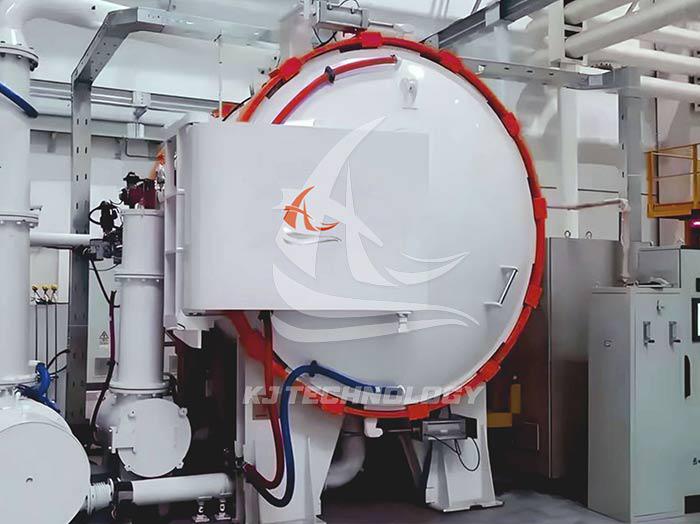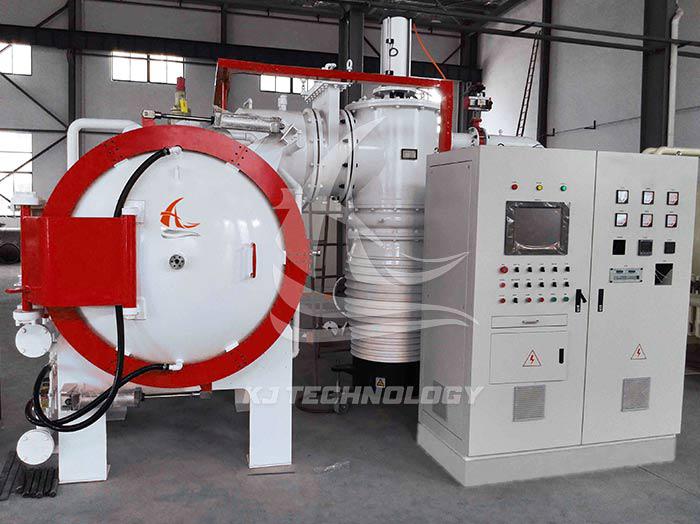Troubleshooting of large-sized furnace vacuum heat treatment furnace
 09-29-2025 Author: KJ technology
09-29-2025 Author: KJ technology
Troubleshooting of large-sized furnace vacuum heat treatment furnaces requires starting from three core modules: electrical faults, vacuum system faults, and mechanical structure faults. A systematic investigation should be conducted based on key parameters such as temperature control, vacuum degree maintenance, and sealing detection. The specific methods are as follows:
1. Electrical troubleshooting
a. Abnormal temperature
Phenomenon: High temperature alarm or display temperature not reaching the set value.
Processing steps:
Check the temperature controller parameters: Compare the temperature controller parameters of other normal devices and calibrate the current device parameters.
Detecting solid-state relay: After power failure, measure the output resistance of the solid-state relay with a multimeter in the resistance range. Normally, it should be several megohms or more. If it is close to zero, it needs to be replaced.
Check the thermocouple: Gently shake the thermocouple probe when powered on, and observe whether the temperature controller displays significant jumping. If the jumping is obvious, the thermocouple needs to be replaced.
Verify the heating tube: After heating with electricity, use a test pen to test whether the connecting wires of the heating tube have electricity. If there is electricity, use a clamp meter to measure whether the current is consistent with other working areas. If the current is abnormal or there is no electricity, check the circuit.
b. Circuit malfunction
Phenomenon: The device cannot start or suddenly loses power during operation.
Processing steps:
Check the power supply: Confirm whether the voltage has reached the specified value. If the voltage is too low, wait for the voltage to stabilize before turning on the furnace.
Check the fuse: If the fuse is blown, replace it with a fuse of the same specification.
Check the silicon rectifier diode: If the diode is damaged, replace it with a new component.
2. Troubleshooting of Vacuum System
a. Insufficient vacuum degree
Phenomenon: The vacuum pump is working but the vacuum degree inside the furnace cannot reach the set value.
Processing steps:
Check the air source: Confirm that the vacuum air source pressure is normal (above -95KPa) and the compressed air pressure is within the range of 0.4-0.6MPa.
Check the vacuum gauge: Compare it with a vacuum gauge in normal use to confirm if the parameters are normal.
Check the sealing:
Check if the furnace door is tightly closed and if the sealing strip is damaged or deformed.
Check if there is any air leakage at the thermocouple inlet, pipeline, pneumatic valve, etc. If the thermocouple is not sealed properly after replacement, it needs to be re sealed with AB glue.
Check the vacuum pump: If the vacuum pump malfunctions, it needs to be repaired or replaced in a timely manner.
b. Vacuum leakage
Phenomenon: The vacuum degree continues to decrease or cannot be maintained.
Processing steps:
Static pressure boosting method: Close the valve to isolate the furnace body from the pump, measure the pressure change over time with a vacuum gauge, and calculate the leakage rate.
Bubble method: Apply soapy water on the surface of the furnace, observe whether bubbles are generated, and determine the location of the leak.
Sealing mud leak detection method: Apply vacuum sealing mud to suspicious locations and observe changes in vacuum degree.
3. Mechanical structure troubleshooting
a. The furnace door cannot be tightly closed
Phenomenon: The furnace door cannot be fully closed, resulting in vacuum leakage.
Processing steps:
Check the hinge and buckle: confirm if the hinge is loose and if the buckle is deformed.
Check the sealing strip: Confirm whether the sealing strip is damaged or deformed, and replace it if there is a problem.
Check the door panel: Confirm whether the door panel is deformed. If it is deformed, it needs to be corrected or replaced.
b. Abnormal noise from the fan
Phenomenon: The fan produces abnormal noise during operation.
Processing steps:
Check for foreign objects: Open the fan casing and inspect for any foreign objects inside the rotor.
Check screws: Confirm if the screws fixing the motor are loose, and tighten them if they are loose.
c. Pneumatic valve cannot operate
Phenomenon: The pneumatic valve cannot be opened or closed normally.
Processing steps:
Check the solenoid valve: Confirm whether the solenoid valve is working properly and whether the compressed air pressure meets the requirements.
Check the pneumatic valve: If the solenoid valve is normal but the pneumatic valve still cannot operate, the pneumatic valve needs to be replaced.








